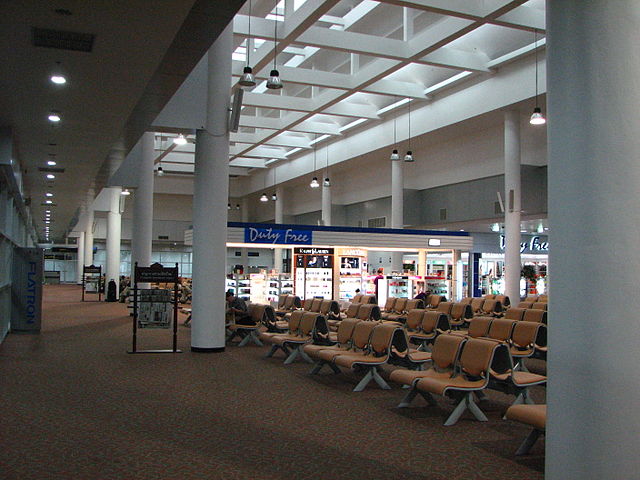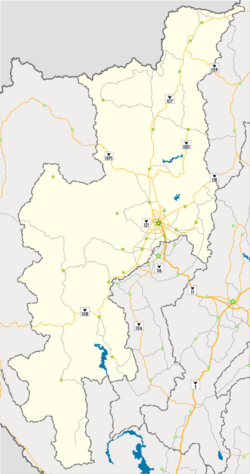Chiang Mai International Airport
Airport in northern Thailand From Wikipedia, the free encyclopedia
Chiang Mai International Airport (IATA: CNX, ICAO: VTCC) is an international airport in Suthep subdistrict, Mueang Chiang Mai district, Chiang Mai province in northern Thailand. It is a major gateway that links northern Thailand to the rest of the region and is currently the fourth-busiest airport in the country. It is managed by Airports of Thailand.
Chiang Mai International Airport ท่าอากาศยานเชียงใหม่ Tha-akatsayan Chiang Mai | |||||||||||
|---|---|---|---|---|---|---|---|---|---|---|---|
 | |||||||||||
| Summary | |||||||||||
| Airport type | Public / military | ||||||||||
| Owner | Royal Thai Air Force | ||||||||||
| Operator | Airports of Thailand | ||||||||||
| Serves | Chiang Mai | ||||||||||
| Location | Suthep, Mueang Chiang Mai, Chiang Mai, Thailand | ||||||||||
| Opened | 1 October 1921 | ||||||||||
| Focus city for | Thai Airways International | ||||||||||
| Operating base for | |||||||||||
| Elevation AMSL | 316 m / 1,036 ft | ||||||||||
| Coordinates | 18°46′00″N 098°57′45″E | ||||||||||
| Website | chiangmai | ||||||||||
| Maps | |||||||||||
 | |||||||||||
Location in Chiang Mai province | |||||||||||
 | |||||||||||
| Runways | |||||||||||
| |||||||||||
| Statistics (2024) | |||||||||||
| |||||||||||

History
Summarize
Perspective



The airport began operations in 1934 as Suthep Airport,[3] after it developed as an airstrip in the early 1920s. Until World War Two, it was used mainly for postal delivery services, with some military use. During the war, it was used by the occupying Japanese forces, and was hence attacked by British and US air forces.[4]
The first scheduled passenger flight to Chiang Mai arrived in 1947, with the foundation of Siamese Airways. At this time and until the late 1950s the runway surface was still grass or dirt, with very few support buildings.[4]
Upgrades in 2014 included expanding the apron for larger planes, extending operating hours to 24/7 (effective April 2014), and enlarging the international arrival hall and domestic departure hall.[5]
Airports of Thailand expanded the terminal with upgrades in 2014 including expansion of the apron for larger planes, extending operating hours to 24/7 (effective April 2014), and enlarging the international arrival hall and domestic departure hall.[5] As of 2018, 31 airlines operated at CNX, serving 11 million passengers, 78,210 flights and 14,612 tonnes of cargo.[6]
As a result of the temporary closure of Suvarnabhumi Airport in 2008 due to the protests, Chiang Mai was used as an alternative stopover for China Airlines flights between Taipei and Europe and for Swiss International Air Lines' Singapore-Zurich flights. On 24 January 2011, the airport became a secondary hub for Thai AirAsia.[7] China Airlines subsequently regularised the stopover.
Facilities
The airport is at an elevation of 316 metres (1,037 ft) above mean sea level. It has one runway designated 18/36 with an asphalt surface measuring 3,100 by 45 metres (10,171 ft × 148 ft).[8] There are two terminals, one for domestic passengers and the other for international flights.[citation needed]
Airlines and destinations
Statistics
Graphs are unavailable due to technical issues. Updates on reimplementing the Graph extension, which will be known as the Chart extension, can be found on Phabricator and on MediaWiki.org. |
Annual passenger traffic at CNX airport.
See Wikidata query.
Traffic by calendar year
| Year | Passengers | Change from previous year |
Movements | Cargo (tons) |
Notes |
|---|---|---|---|---|---|
| 2011 | 3,880,037 | – | 32,445 | 21,484 | |
| 2012 | 4,491,331 | 36,981 | 19,628 | ||
| 2013 | 5,463,921 | 43,366 | 18,188 | ||
| 2014 | 6,630,624 | 52,642 | 17,796 | ||
| 2015 | 8,365,851 | 63,843 | 18,425 | ||
| 2016 | 9,446,320 | 69,202 | 18,512 | ||
| 2017 | 10,230,280 | 71,994 | 17,302 | ||
| 2018 | 10,989,869 | 78,210 | 14,615 | ||
| 2019 | 11,333,548 | 79,504 | 12,313 | ||
| 2020 | 4,851,475 | 39,455 | 4,915 | ||
| 2021 | 1,762,732 | 16,051 | 3,318 | ||
| 2022 | 5,459,481 | 39,027 | 5,584 | ||
| 2023 | 8,224,573 | 55,663 | 5,255 | ||
| 2024 | 9,082,071 | 59,493 | 5,474 | ||
Busiest international routes 2019
| Rank | Airport | Passengers handled | Change % |
|---|---|---|---|
| 1 | 446,398 | ||
| 2 | 323,897 | ||
| 3 | 297,819 | ||
| 4 | 251,805 | ||
| 5 | 232,791 | ||
| 6 | 221,975 | ||
| 7 | 171,918 | ||
| 8 | 128,657 | ||
| 9 | 112,956 | ||
| 10 | 110,614 | ||
Busiest domestic routes 2019
| Rank | Airport | Passengers handled | Change % |
|---|---|---|---|
| 1 | Bangkok–Don Mueang | 3,565,272 | |
| 2 | Bangkok–Suvarnabhumi | 2,866,138 | |
| 3 | Phuket | 415,726 | |
| 4 | Pattaya | 323,547 | |
| 5 | Krabi | 209,382 | |
References
External links
Wikiwand - on
Seamless Wikipedia browsing. On steroids.



